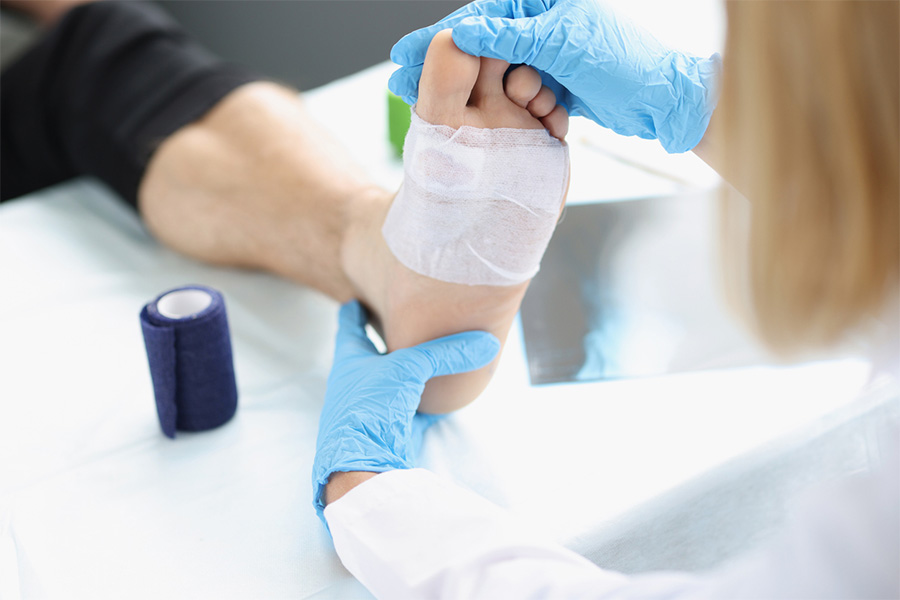Foot ulcers are a common and potentially serious problem for people living with diabetes. They can cause pain, infection, and even amputation if left untreated. Fortunately, foot ulcers can be identified and treated quickly if spotted early.
This guide will help you understand the causes, symptoms, and treatments for foot ulcers.
Identifying Foot Ulcers
Foot ulcers are open sores that appear on the foot, usually on the heel or ball of the foot. They often start as red, swollen areas and can cause severe pain. Ulcers are not like typical cuts or scrapes. They are deeper and more persistent. They also generally take longer than normal to heal.
What Causes Foot Ulcers?
Common causes of foot ulcers include:
- Diabetes – which can damage the nerves in the feet, making it difficult to feel pain or keep track of wounds in the area
- Poor circulation – which can make it harder for wounds to heal properly
- Injury – such as stepping on a sharp object, or wearing ill-fitting shoes
Risk Factors
People with diabetes are especially at risk of developing foot ulcers due to nerve damage and poor circulation. Other factors that can increase your risk include:
- Smoking -increases your risk of poor circulation
- Age – elderly people are more likely to suffer from foot ulcers due to weaker skin
- Deformities or bunions – can make you more prone to injury
- Obesity – can cause extra pressure on the feet
- High blood pressure – can make it hard for the body to heal wounds
- Kidney disease – can cause poor circulation
What Are the Signs and Symptoms?
The signs and symptoms of foot ulcers include:
- Pain – ulcers can be extremely painful, even if there is no visible wound
- Swelling – The area around the ulcer may be hot and swollen
- Redness – the skin surrounding the ulcer can become red and inflamed
- Drainage – Clear or yellow fluid from the ulcer can indicate infection
- Excessive moisture – there may be increased sweating in the affected area
- Discoloration – the skin can appear blueish or purplish
What Sets Ulcers Apart from Typical Wounds?
Cuts, scrapes, and ulcers all share some of the same signs and can look very similar, but they differ. Ulcers are typically much deeper than cuts and scrapes, and the skin surrounding them is often discolored and inflamed. Additionally, ulcers tend to be more persistent. They may not heal as quickly as normal wounds.
Treating Foot Ulcers
Do you think you or someone you know may have a foot ulcer? If so, it’s important to seek medical help as soon as possible. Your doctor will be able to diagnose the ulcer and recommend treatment options.
Diagnosis
Your doctor will likely examine the ulcer to determine its cause and severity. They may also take a sample of tissue or fluid from the ulcer, as well as imaging tests such as an X-ray. Your doctor will also review your medical history and lifestyle.
Treatment
The primary goal of foot ulcer treatment is to promote healing and reduce the risk of further complications. Treatment options can include:
- Cleaning – cleaning the ulcer with saline solution to remove bacteria and debris
- Bandaging – covering the wound with a sterile bandage or dressing to protect it from further damage
- Medications – Antibiotics or corticosteroids help reduce inflammation and prevent infection
- Wound dressings – designed to keep the area dry and protected
- Compression therapy – using bandages or an elastic hose to improve circulation and reduce swelling
- Surgery – In more severe cases, surgery may be necessary to remove dead tissue or repair damage
Surgical procedures are only recommended when other treatments have failed. They usually involve:
- Removing dead or infected skin
- Closing the wound with stitches
- Grafting healthy skin over the wound area
At-Home Care
In addition to your treatment, proper home care can help promote healing and prevent infection. These include:
- Keeping the ulcer clean by washing it every day with saline solution
- Changing your bandages regularly
- Avoiding activities that may aggravate the ulcer, such as walking or standing for too long
- Eating a balanced diet to ensure you’re receiving all of the nutrients you need for healing
- Wearing comfortable shoes to avoid further injuring the area
Prevention
The best way to prevent foot ulcers is to take good care of your feet. You should:
- Keep your blood sugar levels under control
- Inspect and clean your feet daily, paying special attention to any wounds or sores
- Wear properly fitting shoes and socks that don’t rub or chafe
- Avoid walking barefoot
- Have your doctor check your feet regularly, particularly if you have diabetes
The Prognosis
Foot ulcers can be serious, but with timely and proper treatment and care, they can heal without any major complications. If left untreated, ulcers can lead to:
- Infection – which can spread to the bones, joints, and other parts of the body
- Gangrene – an infection that can spread quickly, leading to tissue death and amputation in extreme cases
You can avoid these complications by seeking medical help right away. Also, follow your doctor’s instructions for care.
When to Visit Your Foot Doctor
Seek medical attention immediately if you think you may have a foot ulcer. Prompt treatment can help reduce the risk of infection and further tissue damage.
You should also contact your doctor if:
- Your ulcer isn’t healing properly
- Do you notice any changes in the color, size, or shape of your ulcer
- You develop any new symptoms, such as fever or swelling
- Your ulcer is accompanied by a foul odor
If you have diabetes, make sure you have regular check-ups with your foot doctor. They can assess your feet for any signs of ulcers and provide treatment if needed.
Treatment for Foot Ulcers Near You in Cincinnati, OH
Foot ulcers are a serious condition that can lead to infection and tissue damage if left untreated. You can identify possible ulcers by looking for wounds, openings in the skin, pain, swelling, redness, excessive moisture, and discoloration. If you think you may have a foot ulcer, it’s important to seek medical help right away. Your doctor can diagnose the ulcer and recommend treatment options to help promote healing.
Cincinnati Foot & Ankle Care (CFAC) can provide treatment for foot ulcers near you in Ohio. Call the friendly staff at one of our 17 locations across southwest Ohio, so we can assist you. Also, book a visit with the best foot surgeon near you by submitting an online appointment request form. We look forward to helping you treat for foot ulcer.
Share

People with diabetes often experience difficulty healing wounds.




